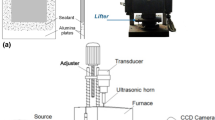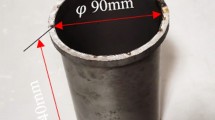Abstract
The size of cavitation region is a key parameter to estimate the metallurgical effect of ultrasonic melt treatment (UST) on preferential structure refinement. We present a simple numerical model to predict the characteristic length of the cavitation region, termed cavitation depth, in a metal melt. The model is based on wave propagation with acoustic attenuation caused by cavitation bubbles which are dependent on bubble characteristics and ultrasonic intensity. In situ synchrotron X-ray imaging of cavitation bubbles has been made to quantitatively measure the size of cavitation region and volume fraction and size distribution of cavitation bubbles in an Al-Cu melt. The results show that cavitation bubbles maintain a log-normal size distribution, and the volume fraction of cavitation bubbles obeys a tanh function with the applied ultrasonic intensity. Using the experimental values of bubble characteristics as input, the predicted cavitation depth agrees well with observations except for a slight deviation at higher acoustic intensities. Further analysis shows that the increase of bubble volume and bubble size both leads to higher attenuation by cavitation bubbles, and hence, smaller cavitation depth. The current model offers a guideline to implement UST, especially for structural refinement.









Similar content being viewed by others
Abbreviations
- A :
-
Vibration amplitude of the sonotrode
- S :
-
Area of cavitation region
- C 0, C 1st, C 2nd :
-
Fitting constants
- Re :
-
Identifier of real number
- Im :
-
Identifier of imaginary number
- Φ :
-
Complex dimensionless parameter
- ρ :
-
Liquid density, 3340 kg/m3
- k mix :
-
Complex wave vector
- α :
-
attenuation coefficient
- α th :
-
Local attenuation corresponding to local intensity Ith
- ω :
-
Wave frequency (ω = 2πf)
- ω 0 :
-
Resonance frequency (Hz)
- c :
-
Sound speed in liquid at ambient pressure (m/s)
- c 0 :
-
Constant sound speed (m/s), 4600 m/s
- c mix :
-
Complex wave velocity
- R :
-
Equilibrium radius of bubbles (m)
- f :
-
Ultrasound frequency (Hz), 20 kHz
- f(r, R):
-
Number distribution of cavitation bubbles with equilibrium radius R at distance r
- f N(r):
-
Normalized form of f(r, R)
- N b :
-
Total number of cavitation bubbles
- β(r):
-
Volume fraction of cavitation bubbles at distance r
- I :
-
Acoustic intensity
- I 0 :
-
Applied acoustic intensity at the radiation face of ultrasonic horn
- I th :
-
Intensity threshold of cavitation, 1.2 MW/m2
- p un :
-
Undisturbed pressure at bubble location (Pa), 105 Pa
- p a :
-
Pressure amplitude (Pa)
- p 0 :
-
Pressure input (Pa)
- σ s :
-
Surface tension, 0.87 N/m
- Φ :
-
Complex dimensionless parameter
- χ:
-
Dimensionless parameter
- γ :
-
Specific heat ratio of gas inside bubbles, 1.4 for air bubble in water[39]
- D :
-
Thermal diffusivity of gas inside bubbles, 8.418 × 10−5 m2/s
- b :
-
Damping factor (1/s)
- μ :
-
Liquid viscosity (Pa s), 1 MPa s for aluminum melt at 700 °C[8]
References
F. Wang, D. Eskin, J. Mi, T. Connolley, J. Lindsay and M. Mounib: Acta Mater., 2016, vol. 116, pp. 354-363.
G. I. Eskin: Ultrason. Sonochem., 2001, vol. 8(3), pp. 319-325.
L. Zhang, D. G. Eskin and L. Katgerman: J. Mater. Sci., 2011, vol. 46(15), pp. 5252-5259.
W. Zhai, Z. Y. Hong, X. L. Wen, D. L. Geng and B. Wei: Mater. Design, 2015, vol. 72, pp. 43-50.
C. Ruirun, Z. Deshuang, M. Tengfei, D. Hongsheng, S. Yanqing, G. Jingjie and F. Hengzhi: Sci. Rep., 2017, vol. 7, pp. 1-15.
X. Liu, Z. Zhang, W. Hu, Q. Le, L. Bao, J. Cui and J. Jiang: Ultrason. Sonochem., 2015, vol. 26, pp. 73-80.
J. Yan, Z. Xu, L. Shi, X. Ma and S. Yang: Mater. Design, 2011, vol. 32(1), pp. 343-347.
G. I. Eskin and D. G. Eskin: Ultrasonic Treatment of Light Alloy Melts. 2nd ed. CRC Press, London, 2014, pp. 17-74.
T. V. Atamanenko, D. G. Eskin, L. Zhang and L. Katgerman: Metall. Mater. Trans. A, 2010, vol. 41(8), pp. 2056-2066.
F. Wang, D. Eskin, J. Mi, C. Wang, B. Koe, A. King, C. Reinhard and T. Connolley: Acta Mater., 2017, vol. 141, pp. 142-153.
A. Ramirez, M. Qian, B. Davis, T. Wilks and D. H. StJohn: Scripta Mater., 2008, vol. 59(1), pp. 19-22.
R. Chow, R. Blindt, R. Chivers and M. Povey: Ultrasonics, 2005, vol. 43(4), pp. 227-230.
D. Shu, B. Sun, J. Mi and P. S. Grant: Metall. Mater. Trans. A, 2012, vol. 43(10), pp. 3755-3766.
S. Labouret and J. Frohly: Eur. Phys. 2002, vol. 19(1), pp. 39-54.
A. Brotchie, F. Grieser and M. Ashokkumar: Phys. Rev. Lett., 2009, vol. 102(8), pp. 4302-4305.
F. Burdin, N. A. Tsochatzidis, P. Guiraud, A. M. Wilhelm and H. Delmas: Ultrason. Sonochem., 1999, vol. 6(1-2), pp. 43-51.
N. A. Tsochatzidis, P. Guiraud, A. M. Wilhelm and H. Delmas: Chem. Eng. Sci., 2001, vol. 56(5), pp. 1831-1840.
T. Matsunaga, K. Ogata, T. Hatayama, K. Shinozaki and M. Yoshida: Compos. Part A, 2007, vol. 38(3), pp. 771-778.
S. Komarov, K. Oda, Y. Ishiwata and N. Dezhkunov: Ultrason. Sonochem., 2013, vol. 20(2), pp. 754-761.
I. Tzanakis, G. S. B. Lebon, D. G. Eskin and K. A. Pericleous: J. Mater. Process. Technol., 2016, vol. 229, pp. 582-586.
I. Tzanakis, G. S. Lebon, D. G. Eskin and K. A. Pericleous: Ultrason. Sonochem., 2017, vol. 34, pp. 651-662.
T. L. Lee, J. C. Khong, K. Fezzaa and J. W. Mi: Mater. Sci. Forum, 2013, vol. 765, pp. 190-194.
H. Huang, D. Shu, Y. Fu, J. Wang and B. Sun: Ultrason. Sonochem., 2014, vol. 21(4), pp. 1275-1278.
W. W. Xu, I. Tzanakis, P. Srirangam, W. U. Mirihanage, D. G. Eskin, A. J. Bodey and P. D. Lee: Ultrason. Sonochem., 2016, vol. 31, pp. 355-361.
L. V. Wijngaarden: J. Fluid Mech., 1968, vol. 33(33), pp. 465-474.
R. E. Caflisch, M. J. Miksis, G. C. Papanicolaou and L. Ting: J. Fluid Mech., 1985, vol. 153, pp. 259-273.
K. W. Commander and A. Prosperetti: J. Acoust. Soc. Am., 1989, vol. 85(2), pp. 732-746.
H. J. Kim, M. H. Chi and I. K. Hong: Journal of Industrial & Engineering Chemistry, 2009, vol. 15(6), pp. 919-928.
L. Nastac: Metall. Mater. Trans. B, 2011, vol. 42(6), pp. 1297-1305.
G. Servant, J. L. Laborde, A. Hita, J. P. Caltagirone and A. Gérard: Ultrason. Sonochem., 2003, vol. 10(6), pp. 347-355.
I. Tudela, V. Saez, M. D. Esclapez, M. I. Diez-Garcia, P. Bonete and J. Gonzalez-Garcia: Ultrason. Sonochem., 2014, vol. 21(3), pp. 909-919.
G. S. B. Lebon, I. Tzanakis, K. Pericleous and D. Eskin: Ultrason. Sonochem., 2018, vol. 42, pp. 411-421.
L. G. S. Bruno, I. Tzanakis, G. Djambazov, K. Pericleous and D. G. Eskin: Ultrason. Sonochem., 2017, vol. 37, pp. 660-668.
H. Huang, D. Shu, J. Zeng, F. Bian, Y. Fu, J. Wang and B. Sun: Scripta Mater., 2015, vol. 106, pp. 21-25.
M. Qian, A. Ramirez and A. Das: J. Cryst. Growth, 2009, vol. 311(14), pp. 3708-3715.
R. Jamshidi, B. Pohl, U. A. Peuker and G. Brenner: Chem. Eng. J., 2012, vol. 189, pp. 364-75.
Z. Xu, K. Yasuda and S. Koda: Ultrason. Sonochem., 2013, vol. 20(1), pp. 452-459.
M. M. van Iersel, N. E. Benes and J. T. F. Keurentjes: Ultrason. Sonochem., 2008, vol. 15(4), pp. 294-300.
C. D. Jr: J. Acoust. Soc. Am., 1959, vol. 31(12), pp. 1654-1667.
Acknowledgments
The authors would like to thank the financial support from the National Key R&D Program of China (No. 2016YFB0701405), the National Science Foundation of China (Nos. 51627802, 51704196, 51771118, and 51704195), the National Science Foundation of China and Steel Joint Project (No. U1760110), and Shanghai Science and Technology Committee (No. 16DZ2260602).
Author information
Authors and Affiliations
Corresponding authors
Additional information
Manuscript submitted December 8, 2017.
Rights and permissions
About this article
Cite this article
Huang, H., Shu, D., Fu, Y. et al. Prediction of Cavitation Depth in an Al-Cu Alloy Melt with Bubble Characteristics Based on Synchrotron X-ray Radiography. Metall Mater Trans A 49, 2193–2201 (2018). https://doi.org/10.1007/s11661-018-4603-6
Received:
Published:
Issue Date:
DOI: https://doi.org/10.1007/s11661-018-4603-6




